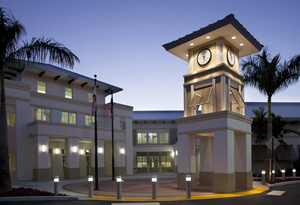There was only one item on the agenda of Wellington’s Planning, Zoning & Adjustment Board on Wednesday, March 11 — the review and approval of the village’s Water Supply Facilities 10-Year Work Plan.
In preparation for the future, Wellington’s Utilities Department submitted its 10-year work plan to the board, which gave its unanimous support.
The meeting began with an introduction of new Planning, Zoning & Building Director Tim Stillings, who took the position after Bob Basehart was promoted to a new position as director of sustainability and regulatory affairs.
“I’m happy to be here and look forward to working with all of you going forward,” said Stillings, who has worked for the village in the past.
Planner Branden Miller gave a succinct presentation to the board on the ordinance, after which Utilities Director Shannon LaRocque was present to address any questions.
Overall, the work plan includes the projected needs for Wellington’s water usage through the year 2040, addressed the expected need for all public services and facilities, and explores alternative water supply projects, water conservation and reuse programs.
“When I got here, one of our main focuses was to secure our water supply through our build-out projection, and that took us three years,” LaRocque explained. “We couldn’t do the 10-year water supply plan until we knew we had our water resources secured. Fortunately, we were able to secure sufficient aquifer water through the district. We have secured freshwater through the build-out. That’s a great win for the village.”
LaRocque continued to explain that the original plan involved securing water from the Floridan Aquifer, which is salty and far more expensive to prepare for use. She went on to describe how utilities tend to plan out 10 to 20 years because the infrastructure projects are expensive.
The plan includes bringing in residents currently on septic and well water into the system, but that is not necessarily a mandatory requirement.
The board asked for clarification of the process of bringing an area, such as Paddock Park, into the public water use system.
“Let’s say you had 200 residents in a neighborhood. If 50 percent plus one agrees to buy in, then you would take it to the Wellington Village Council. Ultimately, it would be the council’s decision to move forward,” LaRocque said. “Then we would initiate a study to determine what the costs are… and then we would present that to the residents.”
LaRocque said these projects are usually community driven, and her staff is available to visit an area and discuss the benefits of connecting to the municipal water system. One significant plus is fire protection, which in turn typically reduces the cost of insurance. Another point is to improve the health and safety of a community’s water source.
Neither water or sewer connection are mandated, nor are they expected to be in the future. The only requirement is that once a water main fronts a property, the Florida Department of Health requires that property connects.
For septic to sewer conversion, both resident and council support are needed. LaRocque made it clear that existing customers do not pay for the switch, but instead individual assessments are made.
The work plan complies with all current Florida statutes and was put together over an 18-month period following the South Florida Water Management District’s approval of the regional water supply plan.
Board Member Maureen Martinez had questions regarding the projections for water usage in the future, specifically in regard to residents currently using private wells. LaRocque noted that in addition to Wellington, the increase in demand comes from new nearby developments. She added that residents using private wells are not motivated to curb their water usage but are still pulling from the same aquifer as village water.
“Wellington has always gotten water from the surficial aquifer. The concern was would there be enough for us to meet build out demands,” she said. “Through engineering, science and modeling, we were able to demonstrate to the water management district that there is enough water in Wellington for us to supply.”
Projects to control water consumption in Wellington include the existing water reuse system and behavioral changes in residents due to drought education.
There were no public comments before or during the meeting regarding the work plan.








